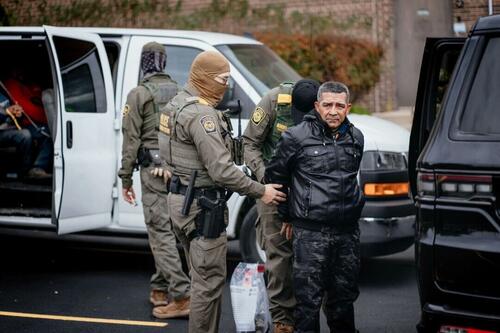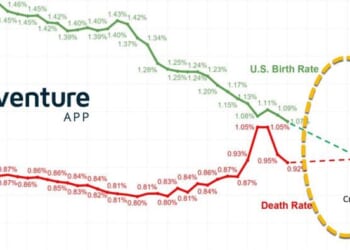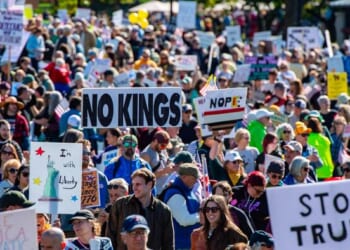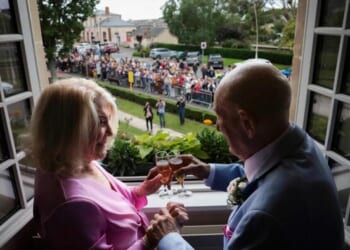A federal judge has restricted the federal government’s use of tear gas and other types of anti-riot measures in Chicago.
On Thursday, Obama-appointed U.S. District Judge Sara Ellis said during a hearing that government witnesses’ claims of violence at protests in Chicago were not credible, citing several occasions where she said video recordings contradicted immigration officials’ accounts about what happened.
“The government would have people believe instead that the Chicagoland area is in a visehold of violence, ransacked by rioters, and attacked by agitators,” she said.
“That simply is untrue.”
The Department of Homeland Security (DHS) in a statement from a spokesperson on the ruling described protesters in the city as “rioters, gangbangers and terrorists” who pose a threat to federal agents.
“Despite these real dangers, our law enforcement shows incredible restraint in exhausting all options before force is escalated,” the DHS spokesperson said, noting that the government would appeal the decision.
The spokesperson described the injunction as “an extreme act by an activist judge that risks the lives and livelihoods of law enforcement officers.”
As Joseph Lord reports for The Epoch Times, Ellis has seen at least one of her earlier rulings related to immigration enforcement in the city overruled, and this latest ruling could face similar challenges if the judge is found to have overstepped her authority by an appellate court. If it isn’t overturned in a higher court, Ellis’s ruling will stay in effect as proceedings related to this issue move forward.
The court hearing comes amid escalating showdowns between protestors opposed to the administration’s immigration enforcement operations and federal agents in America’s third-largest city.
For weeks, protestors and civil liberties groups have alleged that tactics used by Immigration and Customs Enforcement (ICE) have become increasingly aggressive in the city.
Ellis agreed with these allegations in her ruling, finding that the government’s use of force in several cases wasn’t merited by the circumstances on the ground.
Court Order
Ellis ordered the federal government to restrict the use of anti-riot measures against peaceful protestors and members of the press.
The preliminary injunction granted by Ellis restricts agents from using items such as tear gas and pepper balls, “unless such force is objectively necessary” to prevent “an immediate threat.”
It also bars agents from using physical force, including shoving, against protestors and journalists, and requires agents to give two verbal warnings before using riot control weapons.
The order comes after days of testimony about Chicagoans’ encounters with federal agents.
During hours of proceedings on Wednesday, Ellis heard testimony from multiple protestors, journalists, and members of the clergy who said they had been subjected to tear gassing and pepper balls from federal agents during protests in the city.
Witnesses gave testimony about alleged violent encounters with federal agents outside an immigrant detention center in Broadview, Illinois, and on Chicago’s residential streets.
Several people testified that they had had guns pointed at their heads while filming agents, while one pastor testified that he had been struck in the face by a pepper ball while praying.
Ellis granted the preliminary injunction in response to a request brought by some of those affected to restrict the use of federal force against them.
First Amendment
The plaintiffs argued that using excessive force at protests could make individuals less inclined to exercise their rights out of fear of consequences or reprisal.
In her decision, Ellis ruled that there was merit to the plaintiffs’ claims that the government’s conduct could have a chilling effect on First Amendment rights to freedom of speech, assembly, and religion, saying that her order would prevent this.
Federal agents’ use of force, including anti-riot measures, has historically been guided by broad standard requiring the force to be “objectively reasonable,” a standard laid out in the 1989 Supreme Court case Graham v. Connor.
This entails a general requirement to use as little force as possible and respect constitutional rights, while responding proportionately to legitimate threats.
U.S. Justice Department attorney Sarmad Khojasteh argued during the hearing that in every instance, federal agents were justified in their use of force, and told the court that protestors’ actions did not constitute protected First Amendment activity.
Ellis said that in several cases, federal agents had misrepresented events, presenting a different story than events captured on video, in order to justify an escalation of force.
Ellis said during the hearing that Gregory Bovino—the Border Patrol commander-at-large spearheading the administration’s immigration enforcement effort in the city—claimed that he had been hit with a rock prior to throwing tear gas, but that “Video evidence ultimately disproved this.”
According to the judge, Bovino admitted during a deposition that he was struck after tear gas had been dispersed.
Attorneys for the government responded that Bovino has started wearing a body camera since this incident took place, but was not equipped with one at the time. As part of her order, Ellis directed immigration agents to wear body cameras and clearly present their badges or identification.
A similar order was issued by Ellis last month in a temporary restraining order, which expired on Nov. 6.
Loading recommendations…

















